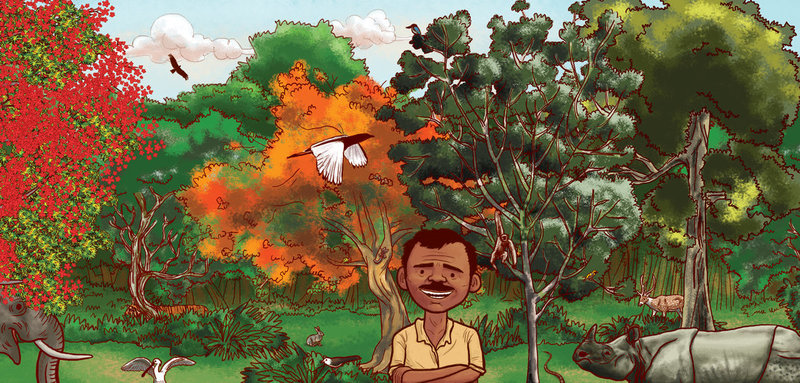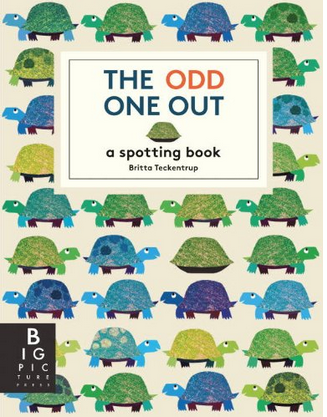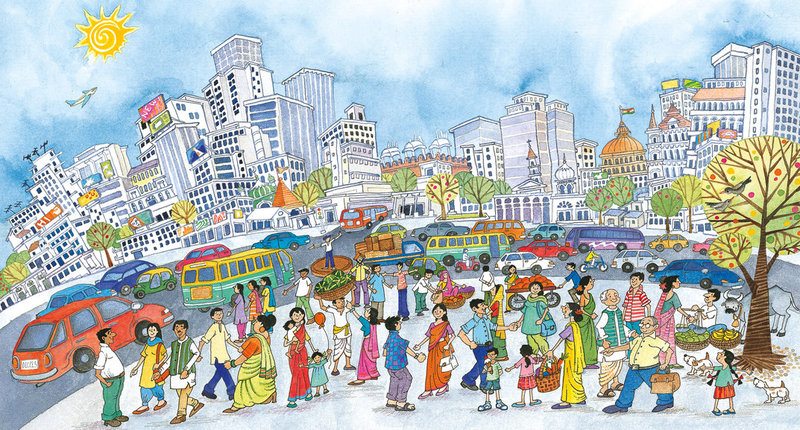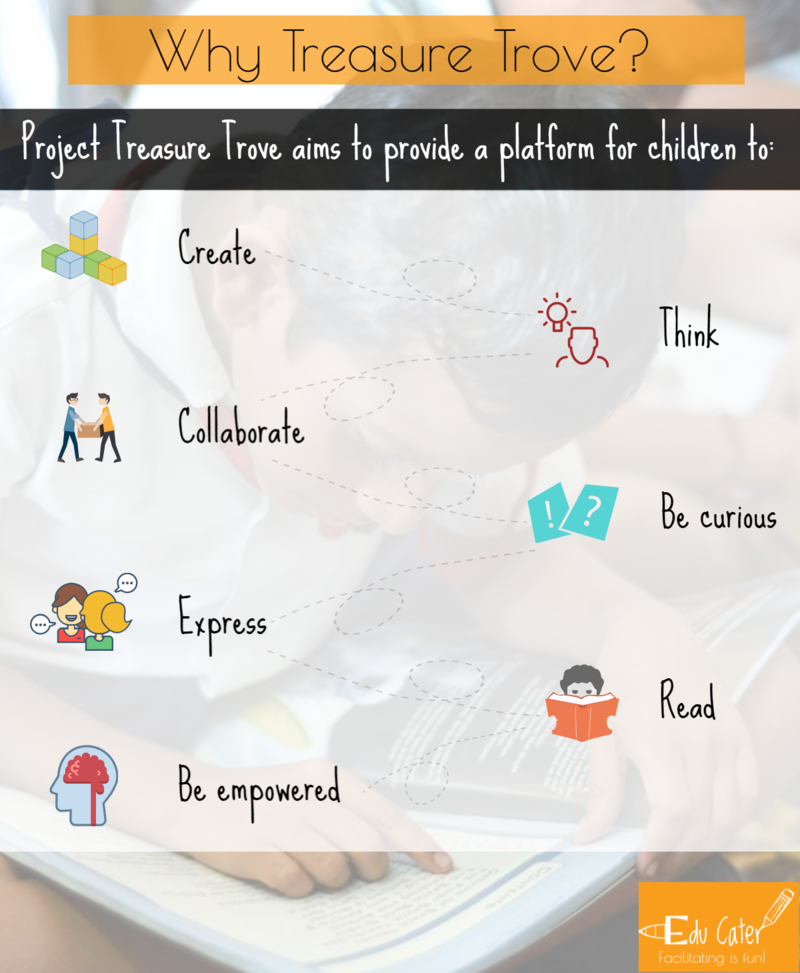Spotting Books That Encourage Children to Sharpen Their Eyes
Posted by Yamini Vijayan on October 28, 2016Spotting books are a great way for children to engage with the book actively and for the reading experience to be an immersive one. It encourages them to explore the illustrations, and also make connections between words and images. We’ve been looking at a range of spotting books and it’s fascinating to see the different ways in which spotting has been made appealing to children. Here are a few books and illustrations that caught our attention!
How many animals and birds can you spot in this illustration by Vinayak Varma from 'Jadav and the Tree-Place'?

Scholastic has a range of spotting books ('I Spy' series). You can see their entire collection here.
Usborne has a collection of really amazing spotting books too: from bugs and butterflies, to adventures under the sea and in the night sky. In these, there are MANY things to spot. Here is an example.
Then there are the really clever ones, like Delphine Chedru’s ‘Spot It!: Find the Hidden Creatures’ and ‘The Odd One Out’ by Britta Teckentrup. In these, there are fewer things to spot but what makes it compelling is the imaginative manner in which the objects or creatures are hidden. It even works as pattern recognition.

Closer home, there are wonderful books by renowned author-illustrator Manjula Padmanabhan which have been published by Tulika. Take a peek at ‘I Am Different!’ and ‘We Are Different!’. Manjula Padmanabhan has also created wordless books for National Book Trust, which are bursting with interesting details because of which they also work as fantastic spotting books. Here's 'A Visit to the City Market' which was published by NBT in 1986.
One of our absolute favourite illustrations from Pratham Books titles' ('City of Stories') is this incredible illustration by the late Bindia Thapar. So much scope for spotting in this, right?

Hope this has inspired you and given you more amazing ideas for Spotathon! For more Spotathon details related to image size, how to submit your entries and the children we work with, click here.
Be the first to comment.Edu-Cater: Helping children discover a Treasure Trove of stories
Posted by Remya Padmadas on October 28, 2016Edu-Cater, is a group of educators who are striving to create 'healthy learning environments'. They design interventions for facilitators who implement them in their respective learning environments. Each module/intervention typically spans 1-2 weeks. While their work encompasses many spaces, The Edu-Cater team strongly believes in the power of books and reading, which prompted them to start a project called Treasure Trove.
Treasure Trove sets up mini-libraries in schools or settings that have limited or no access to books. So far the team has helped set up 3 mini-libraries across Chennai, Tamil Nadu. Of the three, the team engages closely in one of those settings as the other two spaces had all the resources except access to books, which Treasure Trove helped them acquire.
“We work in a school called Sathya Sai school which is in semi-urban environment in North Chennai. Our target group is Class 5 children. Though this school does not have a proper library, there is tremendous support from their end to inculcate the habit of reading.” shared Sriram Sampath, one of the founding members of Edu-Cater.
Siram outlined what the team does via this intervention:
“In the first year of intervention (when kids are in class 5), we empower them with certain skills we deem to be most important like the ability to create, think and collaborate. In the second year of intervention (when kids move to class 6), we want them to feel confident enough to pick up books and read them.”

For both these interventions, Team Edu-Cater is using Pratham Books and StoryWeaver.
Introducing new words and books Treasure Trove shared the story 'The day the vegetables came to school' with children and using the story to introduce them to the words 'Author', 'Illustrator' and 'Translator'.
“We gave all the children a small spiral notepad and encouraged them to maintain their own dictionary in it.” recounts Sriram. “The students carried it with them everywhere to record new words that they come across and their meaning. During the course of sharing this story, students noted down many words that were new to them and asked us for the meanings.”
The team noted how children were excited to note down new words and curious about their meanings. “One of the boys had noted down a few words in his dictionary and had managed to locate the meanings of all the words except one during the course of the week.” remembers Sriram “The moment we entered the class at the next session, he headed straight to us and asked us for the meaning of the word!”
Children found many ways to use the notebook, with one doubling it up as a reference book. “He had drawn the parts of the brain in it. When we asked him why he did this, he told us that he wanted to use the book as a quick reference for tough content!”
Create your own story “We divided the children into teams and showed them the wordless version of 'The Birthday Party'. We then asked each team to come up with their own stories based on the original. It was delightful to see them express their ideas, which was the primary objective of the exercise. But what moved us was when they referred to their dictionary and introduced the new words they had learnt in the stories they weaved. It was amazing!” recounts Sriram “One group of girls was determined to use the new words that they had learnt the previous week. They created their story and were identifying spots where they could insert these new words. This sort of student ownership and little moments are what we call impact.”
When Edu-Cater asked one representative from each team to come forward and share their team’s story, more than one person came forward from each group to read out their stories.
“Many teams had more than one member reading out the stories as a result, and they took turns to do this. It really is a sign of their enthusiasm and confidence, to read!” feels Sriram.
The Treasure Trove project caters to around 85 children currently and there are plans to re-engage with last year's batch, making the total number of children impacted 170.
You can see more images from Edu-Cater sessions here: https://www.facebook.com/facilitatingisfun/photos/?tab=album&album_id=1489288461383170
The team’s future plans for class 6 include the purchase of a Library In A Classroom. “With this in the repository, we are confident that we can get the class 6 kids to pick up books of their choice and start reading!”
Good Luck to Sriram and his team! We look forward to reading more about them and their work!
Be the first to comment.A classical language for a new generation
Posted by Remya Padmadas on October 14, 2016The language referred to as Saṃskṛta, "the cultured language" has long been venerated as a sacred, philosophical and classical literary language. A lingua franca in Greater India, today it is listed as one of the 22 scheduled languages of the country.
The 2001 Indian census reported that 14,000 people identified Sanskrit as their mother tongue and in 2010 Uttarakhand was the first state in India to declare Sanskrit as an official language.
Long looked upon as a classical language, in recent years a movement to revive Sanskrit and introduce it to a new generation of learners has emerged. Podcasts, blogs and websites are attempting to take a language that traces its origins to approximately 1500 - 2000 BC and make it relevant to a generation that is plugged in to Google and YouTube. StoryWeaver is proud to play a small role in the efforts of one organisation working in this realm.
StoryWeaver’s Sanskrit Journey
When StoryWeaver launched in September 2015, the digital open source repository of children’s stories had 24 languages. Within weeks of the launch, requests for new language additions began trickling in. One of them was for Sanskrit.
The request came from volunteers at Samskrita Bharati, a not-for-profit organisation, with its headquarters in New Delhi, and branches in Bangalore, India and San Jose, California. The organisation has been working to revive Sanskrit, in a number of ways. Their 10-day spoken Sanskrit classes are extremely popular and routinely organized all over India and in many major countries worldwide. Students learn conversational Sanskrit in a two hour class every day over a ten-day period and develop the ability to start having Sanskrit conversations.
Vikram Gakhar and Sreenivasan Chakrapani, both volunteer their time and efforts at Samskrita Bharati. It was at Vikram’s behest that Sanskrit was added to StoryWeaver, and in the 10 months since StoryWeaver’s inception, a growing community of Sanskrit enthusiasts have helped created a repository of children’s stories in the language on the site.
Mr Chakrapani is a former electrochemical engineer with a flair for languages. Fluent in English, Tamil, Hindi, Kannada, Italian and German, he chose to pursue the study of Sanskrit post retirement.
“An inner urge took me to Sanskrit soon after retirement. I studied full time and set a target to myself: to be able to write in Sanskrit in two years and teach in the third year. I then volunteered to work for Samskrita Bharathi. They trained me, despite my advanced age, to conduct spoken Sanskrit camps. Since then I am doing my part on a small scale.” shared Mr. Chakrapani.
Mr. Chakrapani has conducted 10 spoken Sanskrit camps so far, and was introduced to StoryWeaver by his colleague at Samskrita Bharathi: Vikram Gakhar.
Vikram is a full time engineer and a part time Sanskrit student/teacher/translator. “I teach Sanskrit to a group of 10 students at my workplace and try to create new material in Sanskrit whenever I get time. I came to know about StoryWeaver from the Pratham Books team at a storytelling session I attended in 2015.”
Both Mr. Chakrapani and Vikram use StoryWeaver to translate stories to Sanskrit with the intent of sharing them with students to help them improve their spoken Sanskrit skills.
“Translating stories on StoryWeaver serves a number of purpose. Creating simple reading material is useful to new students of Sanskrit. It's a fun and effective learning tool for my students which helps them exercise their knowledge of grammar to form sentences. Also, since the stories are available in multiple languages on the platform, one can read and understand the Sanskrit version first and then read the same story in a more familiar language to find out what they didn't get the first time.” shared Vikram.
74 year old Mr. Chakrapani admitted to not being very tech savvy, but found himself using StoryWeaver to translate with ease, thanks to its simple and intuitive user interface.
“We have a large student group and we circulate the translated story link via emails. Even the elders on the group have responded well, with grown ups wanting to read these children’s stories!” enthused Mr. Chakrapani.
Sujatha, another active translator, traces the origins of her translation work on StoryWeaver back to Samskrita Bharati too. An alumnus of the 10 day speaking course, she started reading children’s stories to improve her language skills before progressing to novels in Sanskrit.
“Translating stories for kids is a good way to start one’s learning journey as the language is simpler and helps one gain confidence. StoryWeaver has been a wonderful place for me to practice and hone my skills. ”
Sujatha shares how a dedicated group of Sanskrit enthusiasts get together every evening to converse in Sanskrit and share resources.
“Our group logs on to a Google Hangout every night at 9pm. Whoever is free can join in. We speak to each other in Sanskrit about everything from current affairs to what we are reading. We also use a Google group to document and share the translations we create, including the ones on Storyweaver. This way, it’s easily accessible to everyone.”
StoryWeaver is proud to have collaborators like Mr. Chakrapani, Vikram, Sujatha and their fellow language lovers Suneesh Namboodiri, Govindraj Kasul, Sini Mukundan and Anand Viswanathan. We look forward to seeing more translations by them on the site, and hope that we can be instrumental in sharing them with more people across the world.
Further reading and listening
Sudharma, is the only Sanskrit newspaper in publication today. Printed in Mysore, Karnataka, you can read an online version here.
Balamodini is a podcast of Sanskrit stories read by Samskrita Bharati volunteers from the Sambhashana Sandesha Sanskrit Magazine.
comments (2)